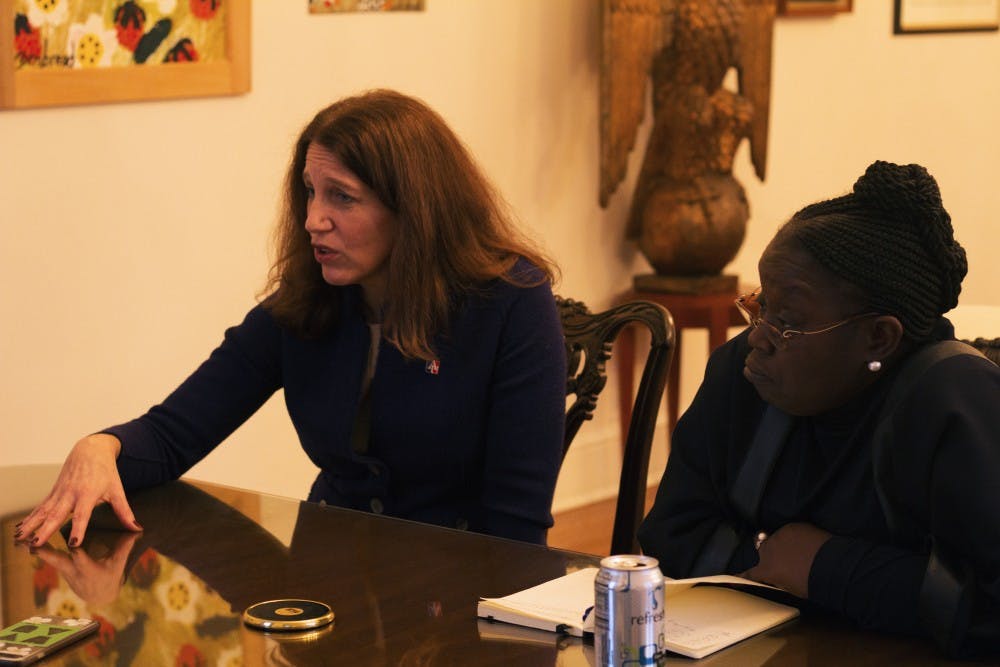Following a year of racist incidents, student-led protests and grim depictions of AU’s campus climate, the University has released its “plan for inclusive excellence,” which lays out AU’s strategy for diversity and inclusion efforts for at least the next two years.
If you don’t have time to read through the 25-page document, consider this your guide to what’s in the plan, how it will be implemented and how progress in diversity and inclusion will be measured. The Eagle spoke to University President Sylvia Burwell ahead of its release. Go here to read the full interview.
The structure of the plan
The plan centers around five central goals, or focus areas:
- Training, learning and development
- Campus climate, culture and community
- Systems, policies and procedures
- Access and equity in hiring and promoting faculty and staff
- Curriculum and instruction
For each focus area, the University commits to a number of specific actions it will take to achieve that goal. For example, under the training portion of the plan, the University commits to implementing a training plan for all “community members and leaders” that will focus on cultural competence and unconscious bias training.
Commitment to improving campus climate
Some of the most notable elements of the plan can be found in the campus climate section, where the University commits to “providing small grant incentives” to encourage collaboration across academic departments and student organizations. Through small group meetings and formal mentoring relationships, the policy also stresses building relationships between students and their would-be mentors at AU: faculty, staff and administrators.
In addition, the University is considering providing designated meeting spaces for registered student groups in order to create a better sense of belonging among students. AU is also exploring the possibility of “living and learning communities” -- university-speak for dorm floors where students attend a class with the same people they live with -- that promote “affinity-based programming for students from diverse backgrounds.”
Moves to increase faculty diversity
Another key concern addressed in the plan: faculty diversity. As of fall 2017, 19 percent of AU’s faculty identified as people of color. Compare that to the student body -- 34 percent identify as people of color, and 11 percent classify as international students, according to data collected by AU.
The University commits to creating a diversity and inclusion body for each school, setting diversity goals for hiring and building pipelines of diverse academic talent to AU. One promise that stands out: a faculty training program meant to eliminate bias in the recruitment and promotion process.
Emphasis on diversity in course curriculum
AU Experience classes, also known as AUx, stand at the center of the University’s curriculum plans. The classes are not a new proposal; they have been piloted among freshmen since fall 2016. By next fall, all first-year students will be required to take the mandatory courses meant to explore the “concept of social identity, and modeling ways of communicating and living in a diverse society,” according to the plan.
Outside of AUx, the University stresses its commitment to “support and develop” the work of the Antiracist Policy and Research Center, led by Ibram X. Kendi, and the new African American and African diaspora studies major, both of which were introduced at AU last year.
How the plan will be implemented
The action steps laid out in the plan will be set in motion starting immediately. Each step has been assigned a department or group of administrators -- in some cases, one administrator -- who will oversee the progress of the goal. One example: the human resources department and the provost will work together to adopt consistent hiring committee policies for faculty hires.
The University is committing about $60 million in the 2018 financial year (academic year 2018-2019) to diversity and inclusion initiatives. About $53 million of those funds goes to institutional scholarships -- namely Pell grants, the Frederick Douglass Distinguished Scholars program and scholarships for veterans and graduate students. The other $7 million funds initiatives like the AUx program and academic centers, among others.
They’ll invest another $61 million during the 2019-2020 school year, and administrators will assess if more funding is necessary in time for the next budget process, which will happen during the 2018-2019 school year.
The ways success will be measured
To measure the University’s progress on its diversity and inclusion goals, administrators will pull statistics from the Office of Institutional Research and Assessment -- including data on the diversity of faculty, staff and students as well as retention and graduation rates. In addition, administrators will consult surveys and focus groups of students, staff and faculty.
What does success look like? The plan offers some examples: an increase in diversity among faculty, students, staff and administrators; increased retention and graduation rates for underrepresented students; and an improved campus climate where more students of color feel a sense of belonging.
The AU community can track results through annual updates issued by the University.
This story has been clarified to reflect that the plan is being implemented immediately.





